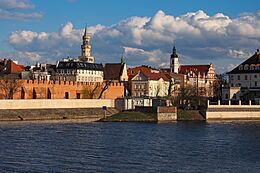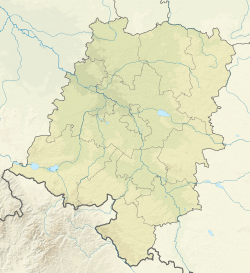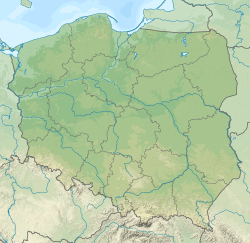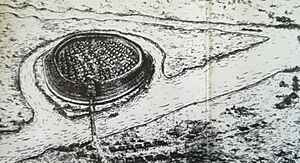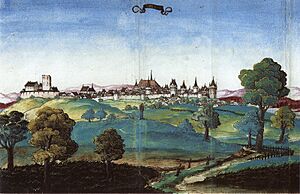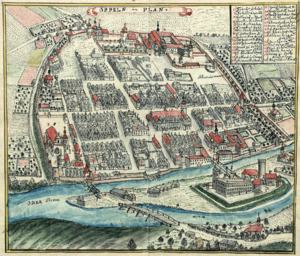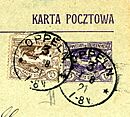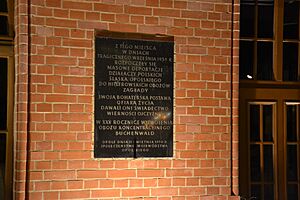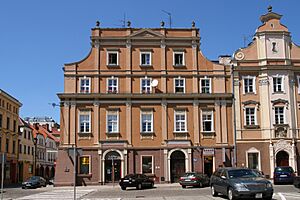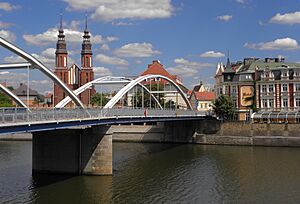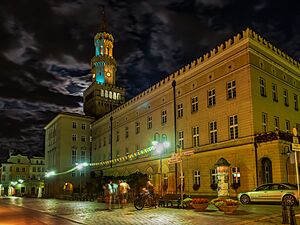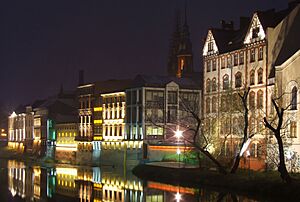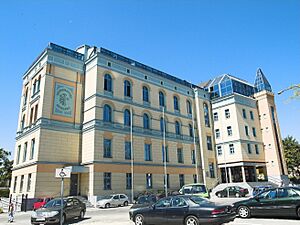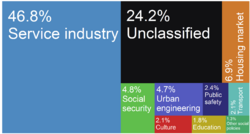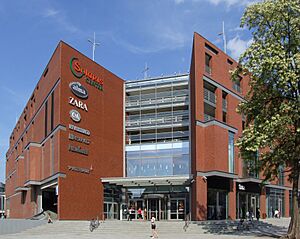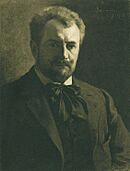Opole facts for kids
Quick facts for kids
Opole
|
|||||
|---|---|---|---|---|---|
|
|||||
|
|||||
| Country | Poland | ||||
| Voivodeship | Opole | ||||
| County | city county | ||||
| Established | 8th century | ||||
| Town rights | 1217 | ||||
| Area | |||||
| • City | 148.9 km2 (57.5 sq mi) | ||||
| • Metro | 338.4 km2 (130.7 sq mi) | ||||
| Elevation | 176 m (577 ft) | ||||
| Population
(31 03 2021 census)
|
|||||
| • City | 127,387 | ||||
| • Density | 856/km2 (2,220/sq mi) | ||||
| • Metro | 146,522 | ||||
| • Metro density | 433/km2 (1,120/sq mi) | ||||
| Time zone | UTC+1 (CET) | ||||
| • Summer (DST) | UTC+2 (CEST) | ||||
| Postal code |
45-001 to 45-960
|
||||
| Area code(s) | +48 077 | ||||
| Car plates | OP | ||||
| Website | https://www.opole.pl | ||||
Opole is a city in southern Poland. It sits on the Oder River. Opole is the historic capital of Upper Silesia. About 127,387 people lived here in 2021. It is the main city of the Opole Voivodeship (province). It is also the largest city in its province.
Opole is one of Poland's oldest cities. Its history goes back to the 8th century. In 1172, it became the capital of a duchy (a small kingdom). In 1217, Duke Casimir I of Opole gave it special "town rights." This helped the city grow. During the Medieval Period and the Renaissance, Opole was a busy trade center. Many important trade routes crossed here. This brought a lot of money to the city.
The city's history includes many cultures from Central Europe. It was ruled by Poles, Czechs (Bohemians), Prussians, and Germans. Opole became part of Poland again in 1945. This happened after World War II. Today, some people of German background still live in the Opole region.
Opole has four universities and colleges. The city also hosts the National Festival of Polish Song in Opole every year. This festival has been held since 1963. Opole is sometimes called "Polish Venice." This is because of its beautiful Old Town and many canals and bridges.
Contents
City Name and Its Meaning
The name Opole probably comes from an old Slavic word. This word meant a group of settlements or villages.
The city has different names in other languages. For example, it is called Uppeln in Silesian. In Czech, it is Opolí. In Latin, it can be Oppelia, Oppolia, or Opulia.
Opole's Rich History
Early Beginnings in Medieval Poland
Opole's story began in the 8th century. Archeologists found the first settlement on Ostrówek Island. This island is in the middle of the Oder River. By the early 10th century, it became a main "gord." A gord was a fortified settlement. It belonged to the Polish Opolans tribe.
Around the year 992, Silesia became part of Poland. It was ruled by the Piast dynasty. From the 11th to 12th centuries, Opole was also a castellan's seat. This meant it was an important administrative center. In 1163, Silesia was divided. Opole became a separate duchy in 1172.
In the early 1200s, Duke Casimir I of Opole moved the settlement. He moved it from the island to the right bank of the Oder River. A castle was built where the old city used to be. The people who moved, along with German merchants, received the first town rights. This likely happened around 1217. Opole got special German town law in 1254.
The city grew a lot under Duke Bolko I of Opole. The castle was finished. New buildings like city walls and the Holy Cross Church were built.
In 1327, the Duchy of Opole became part of the Kingdom of Bohemia. This kingdom was part of the Holy Roman Empire. In 1521, Opole also took over the Duchy of Racibórz.
Under Austrian and Polish Rule
When King Louis II of Hungary and Bohemia died, Opole came under the rule of the Habsburg monarchy of Austria. This happened in 1532. At this time, most people in Opole spoke Polish. There were also Germans, Czechs, and Jews.
The Habsburgs sometimes loaned the duchy to other rulers. This included some monarchs of Poland. In 1655, the King of Poland, John II Casimir Vasa, stayed in Opole. He issued a special order called the Universal of Opole. This order called on Poles to fight against the Swedes. The Swedes had taken over a large part of Poland.
In 1668, King John II Casimir gave up his title as Duke of Opole. The region then went directly to the Habsburgs. By the early 1700s, about 20% of Opole's population was German.
Part of Prussian Silesia
In 1740, King Frederick II of Prussia took most of Silesia from Austria. This happened during the Silesian Wars. Prussian control was confirmed in 1742. Under Prussian rule, the city's population slowly changed. By the early 1900s, about 25% to 31% of Opole's citizens were Polish or spoke two languages.
Opole was still an important center for Poles in Upper Silesia. Polish newspapers were published there. Polish activists like Bronisław Koraszewski worked to protect Polish culture. He started a newspaper called Gazeta Opolska in 1890. He also founded the People's Bank in Opole in 1897.
From 1816 to 1945, Opole was the capital of the Oppeln region within Prussia. The city became part of the German Empire in 1871.
After World War I
After World War I, a vote was held in Opole on March 20, 1921. This vote was to decide if the city would be part of Germany or the newly independent Second Polish Republic. Most people in the city, 94.7%, voted for Germany. However, in the surrounding county, 30% voted for Poland.
Opole was the main administrative city of the Province of Upper Silesia from 1919 to 1939. Between 1928 and 1931, the Piast Castle was torn down. But thanks to strong protests from local Poles, the castle tower was saved. This tower, now called the Piast Tower, is a famous landmark.
Polish activists in Opole faced harsh treatment from 1937 onwards. The local Gestapo (German secret police) watched and spied on Polish activities. They also spread anti-Polish messages. Polish newspapers were often taken away, and their editors were bothered. In 1938–1939, Polish activists were forced to leave the region. On July 2, 1939, a Nazi group attacked Poles going to a church service.
World War II and Its Impact
On August 31, 1939, the day before Germany invaded Poland, mass arrests of important Poles began in Opole. These arrests continued in September. Many Polish leaders, journalists, and bank directors were arrested. They were sent to concentration camps. The local Polish newspaper was shut down. Polish organizations were closed.
German armies attacked Poland from Opole. Special groups called Einsatzgruppen followed them. They committed terrible acts against Polish people. After Poland was defeated, Opole lost its status as a provincial capital.
Polish prisoners from Opole helped start a secret resistance group in Buchenwald camp. Poles who escaped from Opole joined the Polish resistance in occupied Poland.
During the war, the Nazis ran thirteen forced labor camps in Opole. These camps held Allied prisoners of war. The city's New Synagogue, built in 1893–1897, was burned down by Nazis in 1938.
Opole in Modern Poland
After World War II ended in 1945, Opole was given to Poland. This was part of the Potsdam Conference agreements. The city got its original Slavic name, Opole. It became part of the Opole Voivodeship in 1950.
Unlike some other areas, many local people in Opole stayed. They were not forced to leave. Over a million Silesians who saw themselves as Poles were allowed to stay. They had to declare their Polish nationality. Many Poles who were forced to leave their homes in eastern Poland (which became part of the USSR) also moved to Opole.
Later, many Germans and German Silesians moved to West Germany. Today, Opole and its region are known for having a German minority. However, in the city itself, only a small percentage of people identify as German.
On January 1, 2017, several nearby villages became part of Opole. This made the city bigger and added about 9,500 people.
Historical Population Trends
In the early 1900s, official German numbers showed that 25% to 31% of Opole's people were Polish or spoke two languages.
German Minority in Opole
Before 1945, many people in Opole spoke a Silesian dialect. This dialect was strongly influenced by German. Because of this, the Polish government after 1945 did not force all former residents to leave. This was different from other areas. People who spoke this dialect were seen as "local" (Polish). They could stay if they declared themselves as Poles. Some German speakers used this rule to stay in Opole.
Today, the area around Opole has the largest German and Upper Silesian minorities in Poland. But in Opole city itself, only a small number of people identify as German.
Top Sights and Attractions
Opole is famous for its annual National Festival of Polish Song. The city also has the 10th-century Church of St. Adalbert. The 14th-century Church of the Holy Cross is also a key sight. There is also a zoo, the Ogród Zoologiczny w Opolu.
Important Buildings and Structures
- Piast Tower: This is the only part left of the old Piast Castle. It was where the dukes of Opole lived.
- Holy Trinity Church: A 14th-century Gothic church. It holds the tombs of the Opole Piast dukes.
- Town Hall: A beautiful 19th-century building.
- Church of our Lady of Sorrows and St. Adalbert: Also known as the "Church on the Rock."
- Holy Cross Cathedral: A 14th-century cathedral with two tall Gothic towers. It has the tomb of Jan II the Good, the last Piast duke of Opole.
- Art nouveau Penny Bridge: Now called the Green Bridge.
- Opole Main Station: A grand train station building from the early 1900s.
Museums to Visit
- Diocesan Museum
- Opole Regional Museum
- Opole Village Museum
- Central POW Museum: This museum tells the story of prisoners of war.
Other Places of Interest
- The Jewish Cemetery in Opole: Established in 1822, it's a special place for Opole's Jewish history.
Geography and Climate
Opole is one of the warmest cities in Poland. The hottest temperature ever recorded in Poland was near Opole. The climate is mostly oceanic, but also has some continental influences. This means it has mild winters and warm summers.
| Climate data for Opole (1991–2020 normals, extremes 1951–present) | |||||||||||||
|---|---|---|---|---|---|---|---|---|---|---|---|---|---|
| Month | Jan | Feb | Mar | Apr | May | Jun | Jul | Aug | Sep | Oct | Nov | Dec | Year |
| Record high °C (°F) | 15.8 (60.4) |
19.9 (67.8) |
24.5 (76.1) |
29.3 (84.7) |
33.9 (93.0) |
36.0 (96.8) |
37.1 (98.8) |
37.9 (100.2) |
35.4 (95.7) |
26.8 (80.2) |
21.9 (71.4) |
15.2 (59.4) |
37.9 (100.2) |
| Mean daily maximum °C (°F) | 2.5 (36.5) |
4.3 (39.7) |
8.9 (48.0) |
15.5 (59.9) |
20.2 (68.4) |
23.6 (74.5) |
25.8 (78.4) |
25.6 (78.1) |
20.1 (68.2) |
14.2 (57.6) |
8.2 (46.8) |
3.5 (38.3) |
14.4 (57.9) |
| Daily mean °C (°F) | −0.5 (31.1) |
0.7 (33.3) |
4.1 (39.4) |
9.6 (49.3) |
14.2 (57.6) |
17.8 (64.0) |
19.7 (67.5) |
19.4 (66.9) |
14.5 (58.1) |
9.6 (49.3) |
5.0 (41.0) |
0.8 (33.4) |
9.6 (49.3) |
| Mean daily minimum °C (°F) | −3.4 (25.9) |
−2.5 (27.5) |
0.0 (32.0) |
4.0 (39.2) |
8.5 (47.3) |
12.2 (54.0) |
14.0 (57.2) |
13.7 (56.7) |
9.6 (49.3) |
5.8 (42.4) |
2.1 (35.8) |
−1.9 (28.6) |
5.2 (41.4) |
| Record low °C (°F) | −28.0 (−18.4) |
−29.7 (−21.5) |
−22.3 (−8.1) |
−6.8 (19.8) |
−2.5 (27.5) |
−0.1 (31.8) |
4.8 (40.6) |
3.4 (38.1) |
−2.6 (27.3) |
−7.5 (18.5) |
−12.9 (8.8) |
−26.3 (−15.3) |
−29.7 (−21.5) |
| Average precipitation mm (inches) | 31.5 (1.24) |
29.0 (1.14) |
35.2 (1.39) |
36.9 (1.45) |
62.6 (2.46) |
78.2 (3.08) |
89.4 (3.52) |
54.2 (2.13) |
56.7 (2.23) |
41.5 (1.63) |
37.8 (1.49) |
31.9 (1.26) |
585.0 (23.03) |
| Average extreme snow depth cm (inches) | 6.4 (2.5) |
6.0 (2.4) |
3.5 (1.4) |
0.9 (0.4) |
0.0 (0.0) |
0.0 (0.0) |
0.0 (0.0) |
0.0 (0.0) |
0.0 (0.0) |
0.4 (0.2) |
2.4 (0.9) |
4.2 (1.7) |
6.4 (2.5) |
| Average precipitation days (≥ 0.1 mm) | 15.83 | 13.63 | 14.37 | 10.93 | 13.17 | 13.27 | 13.37 | 11.63 | 11.33 | 12.83 | 13.80 | 14.83 | 159.00 |
| Average snowy days (≥ 0 cm) | 14.9 | 11.3 | 4.7 | 0.7 | 0.0 | 0.0 | 0.0 | 0.0 | 0.0 | 0.2 | 3.2 | 8.3 | 43.3 |
| Average relative humidity (%) | 84.0 | 80.4 | 75.3 | 68.9 | 71.8 | 72.1 | 71.3 | 71.9 | 78.0 | 81.8 | 85.0 | 85.1 | 77.2 |
| Mean monthly sunshine hours | 56.1 | 77.6 | 129.4 | 197.5 | 239.4 | 243.0 | 257.2 | 247.4 | 170.0 | 118.2 | 66.9 | 49.6 | 1,852.3 |
| Source 1: Institute of Meteorology and Water Management | |||||||||||||
| Source 2: Meteomodel.pl (records, relative humidity 1991–2020) | |||||||||||||
Education in Opole
Opole has several places for higher education:
- State-run universities and colleges:
- Opole University of Technology
- University of Opole
- Public Higher Medical Professional School in Opole
- Private colleges:
- Management and Administration College in Opole
- Bogdan Jański Academy
- WSB Merito Universities - WSB Merito University in Wrocław (with departments of Economics)
Opole's Economy
Opole is the main center for business and industry in the Opole Voivodeship.
Before World War II, Opole was known for making cement. This was because of the large amounts of limestone nearby. The Cementownia "Odra" cement factory is still active today. The French company Lafarge, which makes building materials, also has a presence here.
Other companies in Opole include:
- Kludi: A German company that makes valves.
- Ahlers: A German company that makes men's fashion.
- Tower Automotive: An American company that makes car parts.
The food industry is also strong in Opole. Big food companies like Zott and Nutricia (part of Danone) are here.
Opole has branches of all major banks. These include PKO, Pekao, Deutsche Bank, and Raiffeisen Zentralbank.
For shopping, Opole has many large stores. These include Metro Cash and Carry and Media-Saturn-Holding. There are also many supermarket chains like Biedronka, Lidl, Aldi, and Netto.
The city has three main shopping centers:
- Solaris Center: Opened in 2009, it has 86 shops. It's in the city center.
- Karolinka Shopping Centre: Opened in 2008, it has 99 stores. It's in the city's suburbs.
- Turawa Park: The smallest of the three, with 50 stores. It's to the east of the city.
Sports in Opole
Opole has several sports teams:
- Odra Opole: A football (soccer) club. They play in the Polish second division. They were in the top league from the 1950s to the 1980s.
- Orlik Opole: An ice hockey club. They play in the top Polish league.
- Kolejarz Opole: A speedway club. They race at the Marian Spychała Speedway Stadium.
- Gwardia Opole: A handball club. They play in the top Polish league.
- Rodło Opole: A football club that started as a youth team. They now have a team in the lower leagues.
Famous People from Opole
- Leo Baeck (1873–1956), a rabbi
- Anna Brzezińska (born 1971), a fantasy writer
- Jerzy Buzek (born 1940), a politician who was President of the European Parliament and former Prime Minister of Poland
- Jan Fethke (1903–1980), a film director
- Damian Grabowski (born 1980), a mixed martial artist
- Jerzy Grotowski (1933–1999), a theater director
- Danuta Jazłowiecka (born 1957), a politician
- Jakub Kania (1872–1957), a Polish poet and writer
- Jan Kasprowicz (1860–1926), a poet
- Miroslav Klose (born 1978), a famous football player for the Germany national football team
- Bronisław Koraszewski (1863–1924), a Polish activist and founder of a newspaper
- Szymon Koszyk (1891–1972), a reporter and Polish activist
- Andrzej Jerzy Lech (born 1955), an artist and photographer
- Chester Marcol (born 1949), an American football player
- Remigiusz Mróz (born 1987), a writer
- Marcin Ociepa (born 1984), a politician
- Edmund Osmańczyk (1913–1989), a reporter and politician
- Emin Pasha (1840–1892), an explorer and governor in Africa
- Bolesław Polnar (born 1952), a graphic artist and painter
- Joachim Prinz (1902–1988), a rabbi
- Krzysztof Szramiak (born 1984), a Polish weightlifter
- Bronisław Trentowski (1808–1869), a Polish philosopher and journalist
- Karolina Wydra (born 1981), an actress
- Piotr Zioła (born 1995), a rock singer
Sister Cities Around the World
Opole is connected with other cities around the world. These are called sister cities:
 Alytus, Lithuania
Alytus, Lithuania Bruntál, Czech Republic
Bruntál, Czech Republic Carrara, Italy
Carrara, Italy Grasse, France
Grasse, France Ingolstadt, Germany
Ingolstadt, Germany Ivano-Frankivsk, Ukraine
Ivano-Frankivsk, Ukraine Kuopio, Finland
Kuopio, Finland Mülheim an der Ruhr, Germany
Mülheim an der Ruhr, Germany Potsdam, Germany
Potsdam, Germany Roanoke, United States
Roanoke, United States Székesfehérvár, Hungary
Székesfehérvár, Hungary
Images for kids
-
Jesuit College, now a regional museum
-
John Paul II Library
See also
 In Spanish: Opole para niños
In Spanish: Opole para niños


